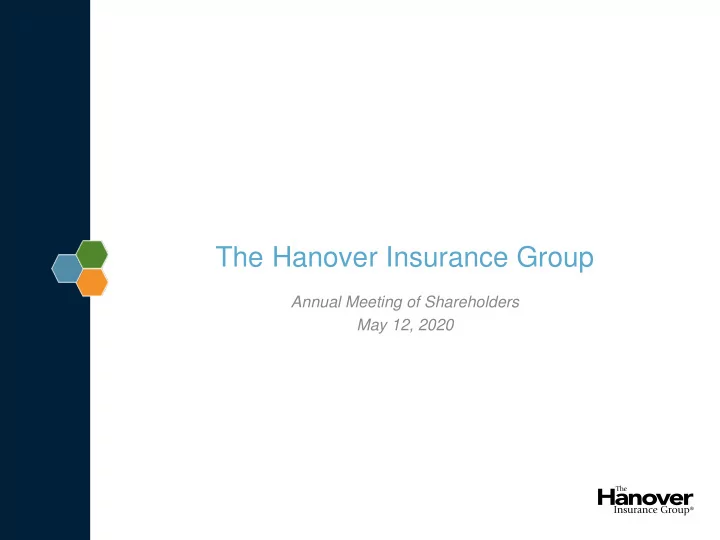

The Hanover Insurance Group Annual Meeting of Shareholders May 12, 2020
Responding to the COVID-19 Pandemic
Agenda Review our: • Competitive position and prospects • Recent performance • Mission to be the premier P&C franchise in the independent agency channel
The Pace of Change is Accelerating
We are Prepared and Positioned to Succeed Agile, responsive Strong financial Proven and business model foundation distinctive strategy Broad and deep Experienced and partnerships committed team
Strong Performance in 2019 Strategic Progress: • Expanded distribution • Enhanced product offerings in Operating Top- NPW all segments Income Per Quartile Growth Share (1) ROE (2) 4.5% + ~20% 12.8% • Drove innovation across the company • Invested in technology, data Improved Improved Combined Expense and analytics Ratio (3) Ratio • Actively managed business mix • Prudently managed capital
Maintained Positive Momentum in First Quarter Top-Quartile NPW Operating Income ROE (2) Growth Per Share (1) 13.1% 3.5% + ~14% Improved Completed $150 Combined Ratio Million ASR
Our Vision and Strategy OUR VISION: To be the premier P&C franchise by helping independent agents transform the way customers experience insurance
Our Collaborative and Agile Culture CORPORATE SOCIAL RESPONSIBILITY
Delivering Value • High-quality products and services • Sustainable profitable growth • Superior returns
Forward-Looking Statements Certain statements in this presentation and comments made by management (or responses to questions) may be “forward -looking stat ements” as defined in the Private Securities Litigation Reform Act of 1995. All statements, other than statements of historical facts, may be forward-looking statements. Wor ds such as, but not limited to, “believes,” “anticipates,” “expects,” “may,” “projects,” “projections,” “plan,” “likely,” “potential,” “targeted,” “forecasts,” “should,” “could,” “cont inu e,” “outlook,” “guidance,” “modeling” and other similar expressions are intended to identify forward-looking statements. Forward-looking statements by their nature address matters that are, to different degrees, uncertain. The company cautions investors that any such forward-looking statements are estimates, beliefs, expectations and/or projections that involve significant judgement, and that historical results, trends and forward-looking statements are not guarantees and are not necessarily indicative of future performance. Actual results could differ materially from those anticipated. These statements include, but are not limited to, the company’s statements regarding: • The company’s outlook and its ability to achieve components or the sum of the respective period guidance on its future result s of operations including: the combined ratio, excluding or including both prior-year reserve development and/or catastrophe losses; catastrophe losses; net investment income; growth of net premiums written and/or net premiums earned in total or by line of business; expense ratio; operating return on equity; and/or the effective tax rate; • The impact of the COVID- 19 outbreak and subsequent global pandemic (“Pandemic”) and related economic conditions on the company’s operating and financial results, including, but not limited to, the impact on the company’s investment portfolio, declining claims frequency as a result of re duced economic activity, severity from higher cost of repairs due to, among other things, supply chain disruptions, and declines in premium as a result of, among other things, cre dits or refunds to the company’s customers, lower submissions, renewals and policy endorsements; • Uses of capital for share repurchases, special or ordinary cash dividends, business investments or growth, or otherwise, and outstanding shares in future periods as a result of various share repurchase mechanisms, capital management framework, especially in the current environment, and overall comfort with capital levels; • Variability of catastrophe losses due to risk concentrations, changes in weather patterns including global warming, terrorism or other events, as well as the complexity in estimating losses from large catastrophe events due to delayed reporting of the existence, nature or extent of losses or wher e “demand surge,” regulatory assessments, litigation, coverage and technical complexities or other factors may significantly impact the ultimate amount of such losses; • Current accident year losses and loss selections (“picks”), excluding catastrophes, and prior accident year loss reserve deve lop ment patterns, particularly in complex “longer tail” liability lines, as well as the inherent variability in property and non -catastrophe weather losses; • The confidence or concern that the current level of reserves is adequate and/or sufficient for future claim payments, whether due to losses that have been incurred but not reported, circumstances that delay the reporting of losses, business complexity, adverse judgments or developments with respect to case reserves, the difficulties and uncertainties inherent in projecting future losses from historical data, changes in replacement and medical costs, as well as complexities related to the Pandemic, including legislative, regulatory or judicial actions that expand the intended scope of coverages, or other factors; • Characterization of some business as being “more profitable” in light of inherent uncertainty of ultimate losses incurred, es pec ially for “longer tail” businesses; • Efforts to manage expenses, including the company’s long -term expense savings targets, while allocating capital to business inve stment, which is at management’s discretion; • Mix improvement, underwriting initiatives, coverage restrictions and pricing segmentation actions, among others, to grow businesses believed to be more profitable or reduce premiums attributable to products believed to be less profitable; balance rate actions and retention; offset long-term and/or short-term loss trends due to increased frequency; increased “social inflation” from a more litigious environment and higher average cost of resolution, increased pr operty replacement costs, and/or social movements; • The ability to generate growth in targeted segments through new agency appointments; rate increases (as a result of its market position, agency relationships or otherwise), retention improvements or new business; expansion into new geographies; new product introductions; or otherwise; and • Investment returns and the effect of macro-economic interest rate trends, including the macro-economic impact of the Pandemic and corresponding governmental initiatives taken in response, and geopolitical circumstances on new money yields and overall investment returns.
Recommend
More recommend